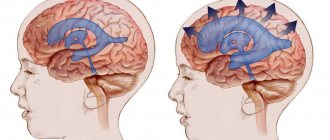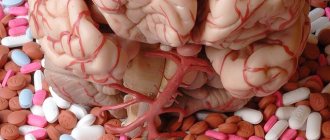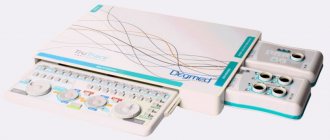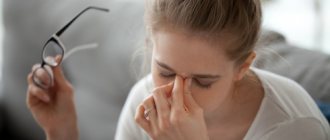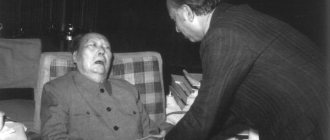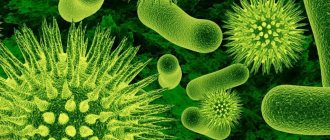Causes of neurological diseases in children
The development of neurological diseases in children under one year of age is usually associated with the peculiarities of the intrauterine development process. Experts name the most common reasons:
- the child receiving a mechanical injury to the spine or brain during childbirth;
- oxygen starvation (hypoxia) of the fetus, which occurs for various reasons, for example, due to repeated entanglement of the umbilical cord around the neck;
- the complex process of childbirth and labor, which leads to infection of the birth canal, an increase in the anhydrous gap, the development of inflammatory complications, bleeding during or after childbirth;
- acute toxicosis of pregnant women throughout the entire period;
- genetic inheritance.
As for children over 1 year old, the root of neurological pathologies should be looked for in:
- low immunity and persistent infectious diseases of the child;
- frequent stress, depression;
- misuse of certain medications, such as antibiotics, anti-inflammatory drugs, corticosteroids;
- excessive stress on the body – physical and mental;
- being in constant fear and depression caused by the behavior of parents and peers at home, in kindergarten, school, clubs and sections;
- excessive emotionality of the child;
- unfavorable environmental conditions;
- diseases of the brain, internal organs, injuries.
Whatever the causes of neurological diseases in children, it is important to promptly detect disorders and begin treatment. The sooner this happens, the less likely it is to develop serious complications and the better the prognosis for recovery.
Tiki
- repetitive movements of an involuntary nature.
They are more common in children aged 4 to 6 years. This is due to the maturation of certain subcortical structures in the brain, which is completed by 7-8 years. If for some reason the child’s body produces a little more activating (or, conversely, a little less inhibitory) neurons than required, and the regime of motor and psycho-emotional stress is not observed, then problems begin in the form of attention deficit hyperactivity disorder, or sleep disturbances or tics. Types of tics: motor (associated with movement - blinking, blinking, squinting, twitching the nose, tugging at clothes); vocal tics associated with breathing (humming, choking, coughing).
A separate, most complex case of generalized tics is Tourette syndrome , when tic manifestations occur in multiple muscle groups, when the same child has several types of vocal tics. They are very pronounced and cause great inconvenience to the child. In this case, examination and treatment by a neurologist is strictly required.
Tics can be transient, i.e. appeared, were observed in the child for some time, and then the excessive activity and increased subsided. But, if the tics continue for more than a year, then these are already chronic tics, so examination and treatment are required.
Symptoms of neurological diseases in children
The first signs of neurological disorders can be noticed in a child at a very early age. You should consult a doctor for help if you experience the following symptoms:
- twitching of the chin and arms at rest;
- throwing your head back while crying;
- lack of reaction to bright light and the sound of a rattle;
- inability to hold a rattle 30 days after birth;
- inability to hold the head 30 days after birth;
- excessive salivation after feeding;
- hyperexcitability (frequent crying) or passive behavior (does not cry at all);
- increased anxiety, sleep disturbances (difficulty falling asleep, sleeping more than 20 hours a day);
- frequent regurgitation in a fountain;
- the occurrence of seizures with a slight increase in temperature;
- hypertonicity (constant tension) of the leg muscles, arching of the body or tilting of the head to the side, which makes it difficult to change the child’s clothes;
- difficulty swallowing food;
- temporary loss of consciousness;
- A 3-month-old baby does not imitate the speech of adults;
- sunken fontanelle;
- the child does not want to sleep on his stomach;
- When leaning on his legs, the child bends his fingers.
As for an older child, the symptoms of neurological diseases in children will be somewhat different:
- forgetfulness, absent-mindedness;
- fainting;
- urinary incontinence;
- delayed speech development;
- excessive nervousness;
- panic attacks;
- the child has difficulty making contact with other children;
- insomnia;
- poor appetite;
- constant despondency and melancholy attitude towards life;
- constant headache.
If parents detect even some of these signs, it is necessary to urgently consult a specialist.
What does a pediatric neurologist treat?
A pediatric neurologist specializes in diseases of the peripheral and central nervous system. The doctor carries out preventive and therapeutic measures for deviations and pathologies in the field.
A child's nervous system is formed in the womb. Pathological development can be affected by many processes:
- toxicosis;
- maternal smoking and drinking;
- infections during pregnancy;
- taking medications.
There are frequent cases of diseases of the nervous system due to unprofessional actions of an obstetrician during childbirth. Often, due to the incorrect position of the child or complications during childbirth, hypoxia and asphyxia of the fetus occurs, which negatively affects the baby’s nervous system.
After birth, the child is examined by a pediatrician. The manipulation is superficial and insufficient to detect specific problems. It is very important after the birth of a child to undergo routine examinations with all specialists.
A pediatric neurologist treats specific symptoms, hereditary and post-traumatic diseases, such as:
- cerebral palsy;
- development problems;
- neuralgia;
- stuttering and speech problems;
- spinal and skull injuries;
- lack of coordination;
- sleep problems;
- neuropathy;
- hyperactivity, etc.
If you notice specific symptoms, you should not wait in line at a public clinic. Among the specialists of private medical institutions there are many narrow specialists.
Reasons for an unscheduled visit to a specialist are:
- Copious and frequent regurgitation (this phenomenon is common, but if the volume of rejected milk is large, it is better to consult a doctor);
- head injuries;
- restless sleep and frequent crying;
- convulsions with fever;
- trembling limbs or chin while crying.
Each period of a child's growing up can reveal specific problems of the nervous system. It is worth paying attention to hyperactivity, anxiety and developmental delay.
List of neurological diseases in children
The list of neurological diseases in children is quite impressive, so we will limit ourselves to listing the most common ones.
- Epilepsy. The disease manifests itself by sudden, recurring convulsive attacks.
- Cerebral palsy . The disease is characterized by limited motor capabilities of the child, difficulties in maintaining an upright posture and walking. Often accompanied by reduced intelligence, delayed speech development and epilepsy.
- Neurosis (psychoneurosis, neurotic disorder) . This name unites a group of reversible disorders, which are characterized by obsessive, asthenic or hysterical manifestations, weakening of both mental and physical performance.
- Hyperactivity . The disease manifests itself in the child’s excessive energy and mobility, impaired attention and sleep, lack of appetite, anxiety and some bad habits, for example, the habit of biting nails.
- Asthenic syndrome . Often occurs as a consequence of traumatic brain injury. It manifests itself as rapid fatigue, irritability, isolation and self-doubt, or a complete loss of the ability to perform physical activity for a long time.
Diagnostics
Conventionally, all methods for identifying neurological diseases can be divided into manual, instrumental and laboratory.
In the first case, the examination is carried out by a doctor in the office using a special hammer. He tests the patient's sensitivity in various ways. If this method is not enough or the problem is serious, the specialist will prescribe additional studies.
Instrumental diagnostics are carried out using electric wave, radiation or ultrasound equipment.
Electrical ones include:
- EEG (electroencephalography) is a painless procedure that will help diagnose epilepsy, panic attacks and migraines. With the help of such equipment, it is possible to detect brain damage due to trauma and concussion.
- Electroneuromyography. It involves recording the electrical activity of muscles and the functioning of the central nervous system. Allows you to identify myotonia, dystonia, stages of development of sclerosis and other similar ailments.
All procedures must be carried out by experienced specialists who are able to identify signs of the disease during diagnosis.
Radiation methods include X-ray, computer, magnetic resonance and nuclear magnetic tomography. They can identify tumors and neoplasms, cysts and traumatic brain injuries. An image of the area being examined is displayed on the screen. The picture can be enlarged or reduced to assess the threat or search for it. Functional methods include those radio wave studies, during which you can see the organ in dynamics.
In modern neurology, ultrasound examinations also help to diagnose diseases: Dopplerography and echocardiography.
Treatment of neurological diseases in children
Treatment of neurological disorders in children includes taking medications that restore the functioning of the nervous system, physical and psychological correction. The child may be prescribed courses of therapeutic massage, special physical education, and exercises in water. Physiotherapeutic methods are often used - stimulation with a high-intensity magnetic field or electric current, laser therapy, ultraphonophoresis of enzyme preparations, electrophoresis and others.
What treatment the doctor will prescribe depends on the child’s age, concomitant diseases, the totality of all the features of the development of neurological pathology from beginning to end, as well as on the effectiveness of correction at the previous stage.
In the city of Penza, you can be examined by a pediatric neurologist and receive qualified assistance at the medical ]"Stoletnik"[/anchor], located at the address: st. Chaadaeva, 95 on the first floor of a five-story residential building. On Wednesdays from 9.00 to 12.00 and on Fridays from 13.00 to 15.00, consultations are conducted by a doctor of the highest qualification category.
MAKE AN APPOINTMENT
Child neurology: Problems originating from childhood
Various injuries in early childhood can have a great impact on the development of pathologies of various types in adulthood. Thus, a concussion can subsequently affect vision loss, and fractures can lead to joint deformation. And often, seemingly completely unrelated phenomena turn out to be links in one chain: for example, a childhood injury to the cervical spine may in the future become a harbinger of the manifestation of autonomic dysfunction in adulthood. Our questions about why such injuries lead to such consequences were answered by neurologist Valeria Olegovna Korotkevich and pediatric neurologists Ekaterina Aleksandrovna Zornina and Alexey Sergeevich Semenov.
Semenov Alexey Sergeevich Functional diagnostics doctor
Zornina Ekaterina Alexandrovna
Various injuries in early childhood can have a great impact on the development of pathologies of various types in adulthood. Thus, a concussion can subsequently affect vision loss, and fractures can lead to joint deformation. And often, seemingly completely unrelated phenomena turn out to be links in one chain: for example, a childhood injury to the cervical spine may in the future become a harbinger of the manifestation of autonomic dysfunction in adulthood. Our questions about why such injuries lead to such consequences were answered by neurologist Valeria Olegovna Korotkevich and pediatric neurologists Ekaterina Aleksandrovna Zornina and Alexey Sergeevich Semenov.
Ekaterina Aleksandrovna, how can birth injuries affect the future health of the child?
Birth injuries are a fairly common problem, because childbirth is an extremely complex process in which many factors influence the child: its position, the mother’s narrow pelvis, obstetric manipulations and much more. All this directly affects the baby's spine. Even minimal deviations from the norm during childbirth can lead to significant complications in development. It is advisable to visit a neurologist three to four times during the first year of life and contact a neurologist in the future as needed. In this case, there is a chance to notice some deviations that parents may not see. After all, clinical pathologies of the nervous system are often detected before the age of 3-5 years. According to statistics, among all diseases of the nervous system in childhood, 50% of them are associated with birth injuries, 30% arise due to genetic reasons, and only 15% are acquired during the process of growth and individual development.
Today, the diagnostic method of neurosonography or ultrasound of the brain has become widespread. It allows you to safely and quickly obtain objective data on the state of the brain. As a screening procedure, this method is highly recommended to be done at a very early age, regardless of the indications. Ultrasound of the cervical spine and computed tomography, if required, are also used.
What injuries can be identified as the most dangerous?
There is a theory that cervical injury during childbirth and early life can subsequently lead to neurological diseases, hypoxic and ischemic lesions, which, in turn, when combined with other causes, can provide or enhance a predisposition to autonomic dysfunction. This is a complex of symptoms of disorders of various body functions, which are caused by a disorder of their nervous regulation. Therefore, we can talk about the consequences in a fairly wide range, because the manifestation of a particular pathology depends on the level of damage to the spine.
In newborns, the manifestation of this syndrome is often practically asymptomatic. But in the future, injuries can indirectly aggravate other pathologies. When it comes down to it, the most common one is minimal brain dysfunction. It usually manifests itself in preschool and early school age with impaired coordination, inability to concentrate, hyperactivity and emotionality, and headaches. I would like to note that if a child at this age cannot calm down or fall asleep for a long time, there is muscle hypertonicity or, on the contrary, he is too sluggish, has poor articulation or pronunciation problems - all this is a reason to visit a neurologist. Alexey Sergeevich, how is therapy for children when neurological pathologies are identified?
To begin with, a thorough examination is carried out. And since neurological diseases most often have a borderline nature with the psychological and pedagogical spheres, the approach and treatment itself are applied comprehensively. So, a psychologist or chiropractor can be involved, and the whole family should be involved in the correction process. Psychological, pedagogical and neuro-psychological therapy is used, and there is also medicinal treatment for individual indications, osteopathy and manual therapy. Of course, the younger the child, the greater the compensatory capabilities of his body, that is, the treatment is faster and easier.
But in any case, we must not forget about prevention. It is very important that parents understand that the rotational and adaptive mechanisms of the child’s body cannot be blocked. That is, you should not wrap your child up in the same way as in the first month of life; you need to take a rational approach to his physical and psychological development, giving him the opportunity to explore the world on his own in combination with reasonable restrictions and upbringing. Then neurological and other problems can often be avoided.
Valeria Olegovna, can childhood neck injuries make themselves felt in adulthood?
Of course, pathologies that are not detected in time can lead to the development of diseases, in particular to impaired blood supply. Indeed, as a result of injuries to the cervical spine, both birth and acquired, arteries can be damaged. Even a minimal disturbance in the relationship between the vertebrae in the neck leads to a deterioration in the blood supply to the brain - both in childhood and adolescence, and in adulthood. This can manifest itself as headaches, dizziness, and loss of consciousness.
Is autonomic dysfunction a consequence of a cervical spine injury?
This cannot be said to be a direct relationship, but such injuries can indirectly affect the development of this syndrome. In any case, autonomic dysfunction (autonomic dysfunction syndrome) or, as it is also called, vegetative-vascular dystonia appears, first of all, as a result of the constitutional structure, genetic characteristics, stress and lifestyle, and is also provoked by injuries to the cervical spine. Taken together, spinal curvature, other diseases and injuries can cause this syndrome. Often, under the influence of physical activity, unprepared people develop vascular disorders, and to prevent this from happening, it is important to maintain a sports regime and move more.
Depending on the type of disorder, dysfunction is manifested by high blood pressure, heart rhythm disturbances, headaches, weakness, malaise, and others. In some cases, impaired circulation of cerebrospinal fluid and impaired venous circulation, due to birth injuries to the nervous system, can lead to the development of hypertension syndrome. It is a brain lesion resulting from increased intracranial pressure combined with an increase in the amount of cerebrospinal fluid in the brain. The syndrome has the following symptoms: blurred vision, convulsions, headaches, impaired consciousness, nausea and vomiting.
How are autonomic dysfunction and other neurological syndromes treated?
To get rid of autonomic dysfunction for adults, the Scandinavia clinic uses medicinal methods, acupuncture and reflexology, manual therapy, and homeopathy also helps many. Vegetative-vascular dystonia can cause serious endocrine diseases and cardiac disorders, so it is very important to consult a specialist, undergo an X-ray, MRI and ultrasound examination as directed.
For more information and to schedule a consultation, please call (812) 600-77-77
or by filling out the form on the website.
Literature:
- Belyaeva I. A., Bombardirova E. P., Tokovaya E. I., Kharitonova N. A., Lazurenko S. B., Turti T. V., Illarionova M. S. Non-drug habilitation of children with perinatal lesions of the nervous system / / Issues of modern pediatrics. – 2021. – No. 16 (5). – pp. 383–391.
- Bombardirova E. P., Yatsyk G. V., Stepanov A. A. Treatment and rehabilitation of perinatal lesions of the nervous system in children in the first months of life // Attending physician. – 2005. – 2. – P.67–69.
- Petrukhin A. S., Pylaeva O. A. Current problems of pediatric neurology // General Medicine. – 2005. – No. 2. – P. 3–11.
How to stay healthy
The main reason for the appearance of diseases of this type is disruption of the nervous system. If they have not been a pathology since childhood, then their occurrence can be triggered by chronic fatigue, constant stress at work and at home, bad habits, as well as a lack of vitamins in the body. To prevent the development of neurological diseases, you just need to:
- exercise – preferably regularly, and not a couple of months of intense exercise a year in order to “lose weight by summer”;
- rest fully - this means healthy sleep of at least 8 hours a day (at night, not during the day);
- eat right - it is with food that we get all the nutrients the body needs, so watch what’s on your table;
- walk in the fresh air - it doesn’t matter whether you decided to take a walk after work or deliberately went to the park. If the weather permits, and things can wait 15–20 minutes, then why deny yourself the pleasure.
Alcohol and tobacco abuse can also cause neurological diseases. Toxic substances have a destructive effect on the entire body as a whole. Do you smoke? Drop it! The body will thank you with good health and excellent mood. As for alcohol, nothing bad will happen from a glass of good wine with dinner. The main thing is to know when to stop.

